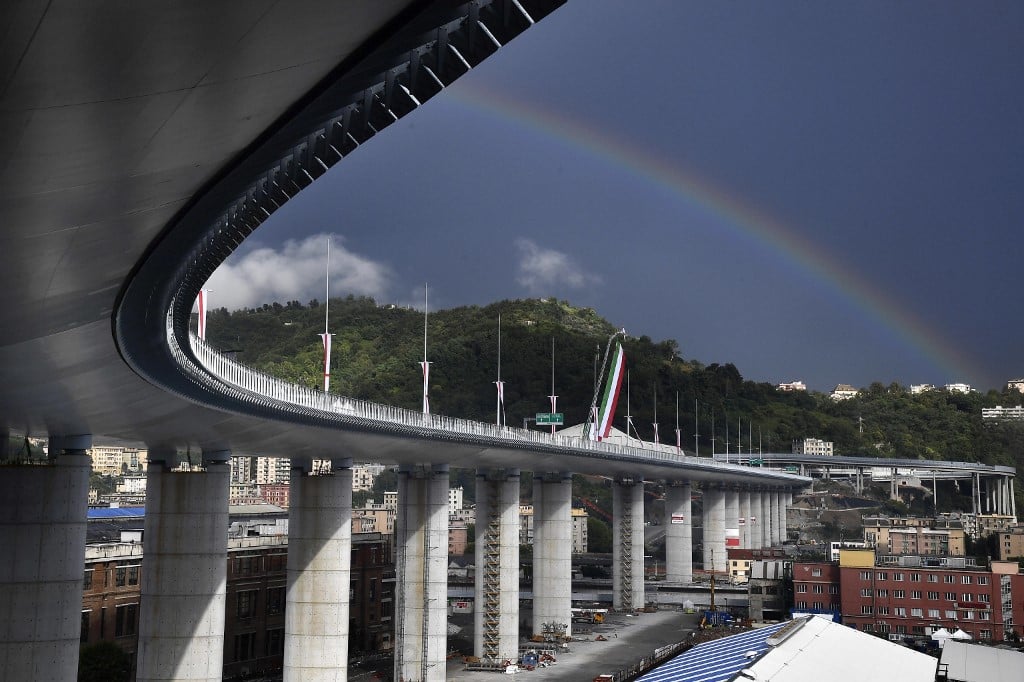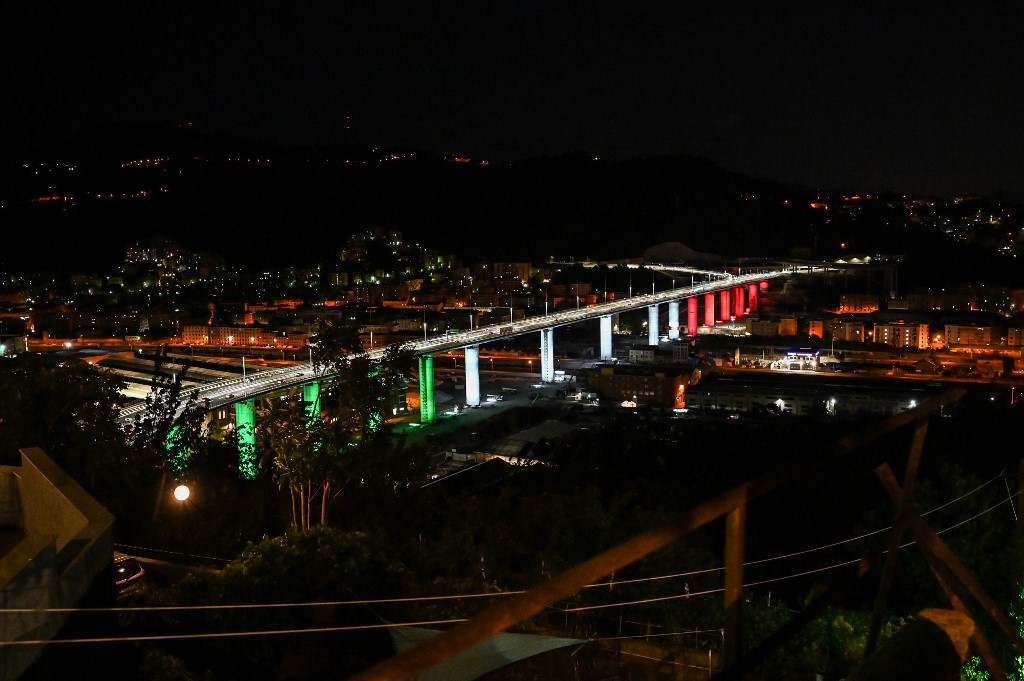Could Genoa's new bridge show Italy the way to overhaul its infrastructure?

A gleaming new bridge in Genoa built after the deadly collapse of a viaduct opened on Tuesday, but critics say not enough has been done since the 2018 disaster to overhaul Italy's crumbling infrastructure.
The first cars crossed the sleek steel structure just after 9 pm, nearly two years to the day the Morandi highway gave way during heavy rain, hurling dozens of vehicles into the abyss and killing 43 people.
The San Giorgio bridge, designed by famed Italian architect Renzo Piano, was inaugurated to much fanfare on Monday. But many of the relatives of the victims declined to attend, saying the ceremony overshadowed the 2018 tragedy.
READ ALSO: 'Born of tragedy': Italy inaugurates new bridge to replace Genoa's collapsed highway
"We're still there, at the collapsed bridge, with the people we lost under the bridge. We're stuck in 2018," Giorgio Robbiano, 43, who lost his brother, sister-in-law and nephew in the disaster, told AFP on Tuesday.
However, he said: "the bridge had to be built and we're happy for the city... It was also important to show that large works could be successfully finished in time, without complications."

A rainbow over the new bridge at the inauguration ceremony on Monday. Photo: Marco Bertorello/AFP
The tragedy shone a spotlight on the country's decaying roads, bridges and railways. The Morandi's speedy demolition and replacement has been hailed by many as an example of what Italy could be, should it scrap its infamous red tape.
The centre-left coalition government promised during the coronavirus pandemic this year to use major infrastructure projects to reboot the battered economy, as Italy slid towards its worst recession since World War II.
It said it would radically simplify bureaucracy to unblock some €62 billion of construction work, and promoted the "Genoa model": a code-word for work done efficiently and quickly under the watch of a special commissioner.
READ ALSO: Could rebuilding Italy's crumbling roads and bridges save the post-lockdown economy?
The country has at least 50 large infrastructure projects that are stalled, from a high-speed train in Sicily to the widening of a motorway in Tuscany, Italy's construction lobby ANCE said.
Projects stutter to a halt or fail to get off the ground due to lengthy legal challenges to tenders, companies going bankrupt, political point scoring or local council spats, including one in Liguria over which town should host the station on a new train line.
The funds are there: according to the Cresme research institute, there were some €200 billion earmarked for the sector at the end of 2019, ranging from government and EU funds to private contributions.
Last month the government approved a "simplification decree" -- touted by Prime Minister Giuseppe Conte as "the mother of all reforms". But detractors said it failed to make serious inroads into red tape, and could even prove damaging.

The first cars drive over the new San Giorgio bridge, lit in the colours of the Italian flag. Photo: Andreas Solaro/AFP
Infrastructure executive Angelica Donati said it takes twice as long in Italy to carry out a large-scale infrastructure project than in the rest of Europe, so speeding up the process and improving efficiency and transparency would be much welcomed.
But she warned that the new decree crushed competition, by effectively excluding the small and medium enterprises that make up the backbone of Italy from tenders for projects worth over €5.3 million.
For the next two years, the public administration can rule such projects be treated as an emergency "because of the Covid-related crisis... which would exclude them from all public tender regulations, apart from anti-mafia ones", she told AFP.
READ ALSO:
-
Did Italian authorities know Genoa's Morandi Bridge was at risk of collapse?
-
Genoa bridge collapse: The mafia's role
-
'Thousands of Italian bridges will be in crisis in the next 20 years'
A small number of specific companies can be invited to participate individually in the tender -- penalising those who would have made joint venture bids, or are simply excluded.
"Using the commissioner structure and throwing out the rule book, saying you have full power to do whatever you want, is not the right way to ensure transparency and protect competition," Donati said.
"The Genoa model is a very bad idea, it's very dangerous," she said, and risks turning Italy into "the Wild West".
By AFP's Ljubomir Milasin
Comments
See Also
The first cars crossed the sleek steel structure just after 9 pm, nearly two years to the day the Morandi highway gave way during heavy rain, hurling dozens of vehicles into the abyss and killing 43 people.
The San Giorgio bridge, designed by famed Italian architect Renzo Piano, was inaugurated to much fanfare on Monday. But many of the relatives of the victims declined to attend, saying the ceremony overshadowed the 2018 tragedy.
READ ALSO: 'Born of tragedy': Italy inaugurates new bridge to replace Genoa's collapsed highway
"We're still there, at the collapsed bridge, with the people we lost under the bridge. We're stuck in 2018," Giorgio Robbiano, 43, who lost his brother, sister-in-law and nephew in the disaster, told AFP on Tuesday.
However, he said: "the bridge had to be built and we're happy for the city... It was also important to show that large works could be successfully finished in time, without complications."

A rainbow over the new bridge at the inauguration ceremony on Monday. Photo: Marco Bertorello/AFP
The tragedy shone a spotlight on the country's decaying roads, bridges and railways. The Morandi's speedy demolition and replacement has been hailed by many as an example of what Italy could be, should it scrap its infamous red tape.
The centre-left coalition government promised during the coronavirus pandemic this year to use major infrastructure projects to reboot the battered economy, as Italy slid towards its worst recession since World War II.
It said it would radically simplify bureaucracy to unblock some €62 billion of construction work, and promoted the "Genoa model": a code-word for work done efficiently and quickly under the watch of a special commissioner.
READ ALSO: Could rebuilding Italy's crumbling roads and bridges save the post-lockdown economy?
The country has at least 50 large infrastructure projects that are stalled, from a high-speed train in Sicily to the widening of a motorway in Tuscany, Italy's construction lobby ANCE said.
Projects stutter to a halt or fail to get off the ground due to lengthy legal challenges to tenders, companies going bankrupt, political point scoring or local council spats, including one in Liguria over which town should host the station on a new train line.
The funds are there: according to the Cresme research institute, there were some €200 billion earmarked for the sector at the end of 2019, ranging from government and EU funds to private contributions.
Last month the government approved a "simplification decree" -- touted by Prime Minister Giuseppe Conte as "the mother of all reforms". But detractors said it failed to make serious inroads into red tape, and could even prove damaging.

The first cars drive over the new San Giorgio bridge, lit in the colours of the Italian flag. Photo: Andreas Solaro/AFP
Infrastructure executive Angelica Donati said it takes twice as long in Italy to carry out a large-scale infrastructure project than in the rest of Europe, so speeding up the process and improving efficiency and transparency would be much welcomed.
But she warned that the new decree crushed competition, by effectively excluding the small and medium enterprises that make up the backbone of Italy from tenders for projects worth over €5.3 million.
For the next two years, the public administration can rule such projects be treated as an emergency "because of the Covid-related crisis... which would exclude them from all public tender regulations, apart from anti-mafia ones", she told AFP.
READ ALSO:
- Did Italian authorities know Genoa's Morandi Bridge was at risk of collapse?
- Genoa bridge collapse: The mafia's role
- 'Thousands of Italian bridges will be in crisis in the next 20 years'
A small number of specific companies can be invited to participate individually in the tender -- penalising those who would have made joint venture bids, or are simply excluded.
"Using the commissioner structure and throwing out the rule book, saying you have full power to do whatever you want, is not the right way to ensure transparency and protect competition," Donati said.
"The Genoa model is a very bad idea, it's very dangerous," she said, and risks turning Italy into "the Wild West".
By AFP's Ljubomir Milasin
Join the conversation in our comments section below. Share your own views and experience and if you have a question or suggestion for our journalists then email us at [email protected].
Please keep comments civil, constructive and on topic – and make sure to read our terms of use before getting involved.
Please log in here to leave a comment.